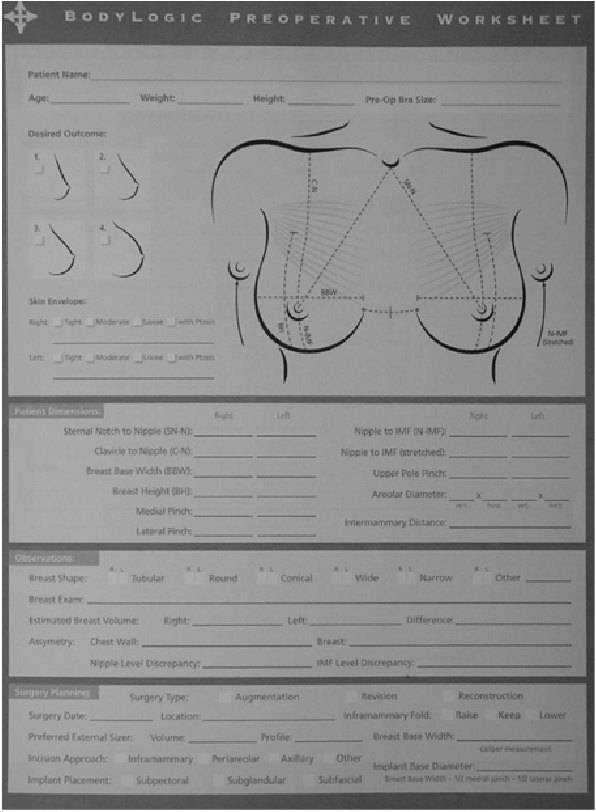
Figure 1a: Preoperative Worksheet


Umar Choudry*1 Nicholas Kim2 Bruce Cunningham1
1Division of Plastic Surgery, University of Minnesota, Minneapolis, MN, USA*Corresponding author: Umar Choudry, Division of Plastic Surgery, University of Minnesota, Minneapolis, MN, USA, E-mail: choud008@umn.edu
Purpose: Preoperative systems that mathematically select “the one best implant” have been developed. However, they fail to take into account the patient’s desires regarding aesthetic outcome. This prospective study evaluates an anthropometrically-based system, which enables both the surgeon and patient to choose an appropriate implant.
Methods: Nine plastic surgeons enrolled every patient operated on for primary breast augmentation from September 2008 - 2010. They based all their implant choices on the described system. Postoperative outcomes in terms of satisfaction and reoperation rates were studied.
Results: One hundred and forty two primary breast augmentation patients were enrolled and followed during the 2-year enrollment period. The mean overall and breast size satisfaction rates at the 3-month and 12-month time periods reported by patients were 94.7% and 93.64%, respectively; and by surgeons were 94.86% and 94.84%, respectively. There were no reoperations reported for size change at 5 years. We found that 44 (31%) patients had ≥ 3 high risk factors (HRF) for poor outcome. Eleven (25%) of them had a ≤ 80% satisfaction rate, compared to 8 (8.2%) of the patients who had <3 HRF (p=0.014). Despite this, the vast majority of this difficult patient population (n=33, 75%) had a >80% satisfaction rate with the use of this system.
Conclusions: The anthropometrically-based system guided surgeons and patients effectively in choosing implants that resulted in high outcome satisfaction rates and no reoperations for size change. This system was especially successful in difficult cases that have a high risk for poor outcome.
Breast Augmentation; Anthropometric Measurements; Patient desires; Reoperation rates; Size Change; Outcome
Breast augmentation remains the most commonly performed aesthetic surgical procedure since 2006 [1]. The lifting of the ban by the FDA on silicone implants for aesthetic augmentations in 2006 was instrumental in it overtaking liposuction to the top of the list. Despite the advances in implant technology, and well-established surgical techniques, reoperation rates of 13-20 percent are quoted in the literature [2-9]. These high rates are disappointing to both the patient and the surgeon. The indications for reoperations include capsular contracture, implant malposition/rotation, implant rupture, infection, extrusion, and size change, many of which are secondary to improper implant choice or complications resulting from poor implant placement and/or selection. This is especially true for reoperations for size change, which are reported to be as high as 8.7 percent [2-9].
Over the years, plastic surgeons have applied more objective parameters preoperatively in an effort to assess the breast and select the proper implant [10-18]. By taking into account the patient’s tissue characteristics through standard anthropometric measurements, and using them as guidelines to mathematically deduce the implant size and placement, a decrease in reoperation rates with high patient satisfaction has been shown. What these systems do not take into account are the patients’ desires with regards to final volume and aesthetics, especially patients who envision very large implants. In an effort to bridge the gap, a system was developed that took both perspectives into consideration. This preoperative worksheet is intended to help surgeons choose more accurately the size, shape, type, and location of breast implants, by taking into account individual patient anthropometric measurements and tissue characteristics, as well as their expectation and aesthetic vision of their breast enhancement surgery.
The purpose of the study was to evaluate this system in a prospective manner, with the hypothesis that the use of such a system would result in lower reoperation rates with high patient and surgeon satisfaction by enabling both the surgeon and patient to choose the appropriate implant.
We identified nine plastic surgeons who perform breast augmentations on a regular basis, and invited them to participate in our study. We provided each of them with a packet that included the anthropometric-based system kit, along with detailed instructions about the project. This kit included: Preoperative worksheets (Figure 1a and 1b), an implant selection booklet, and calipers for the required anthropometric measurements (Picture 1). Additionally, the packet included: 1-3 month postoperative worksheets, 8-12 month postoperative worksheets (Figure 2), and reoperation forms (Figure 3).

Figure 1a: Preoperative Worksheet
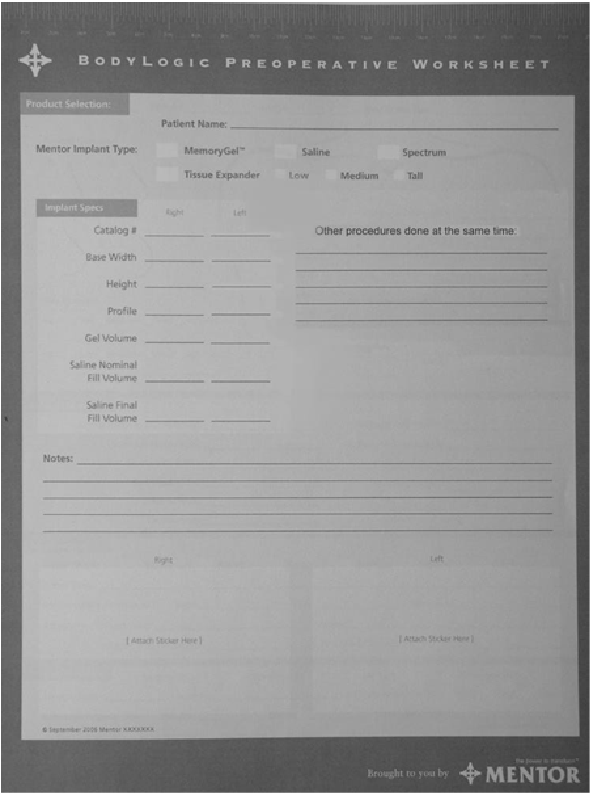
Figure 1b (Con’t): Preoperative Worksheet
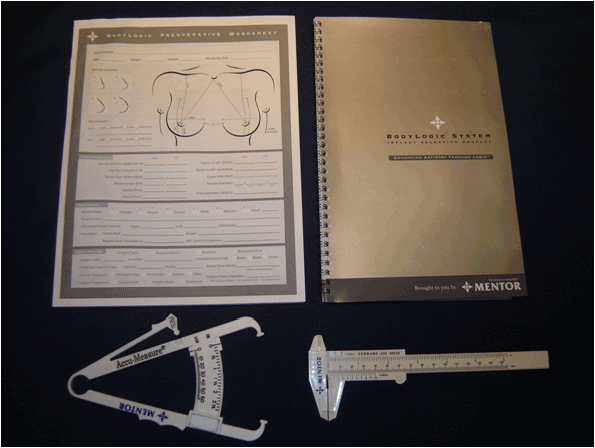
Picture 1: The Anthropometric-Based Implant Selection System Kit: Preoperative worksheets, implant selection booklet, and calipers.
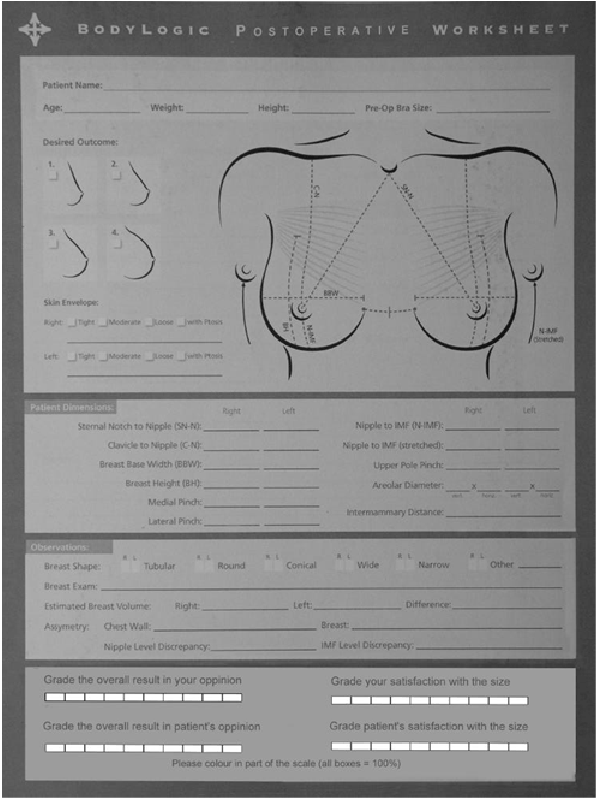
Figure 2: Postoperative Worksheet
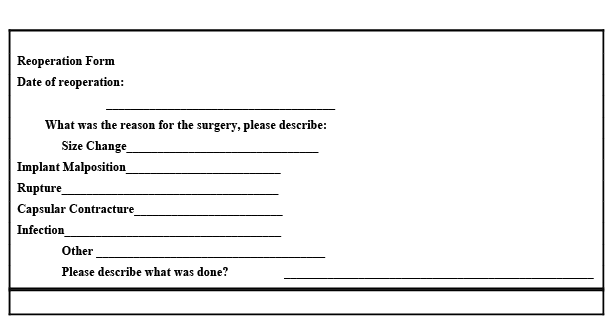
Figure 3: Reoperation Form.
Each surgeon was asked to enroll every patient that he/she operated on for breast augmentation from September 2008 to September 2010. The surgeon was asked to complete the preoperative worksheet and then use the information to choose the appropriate implant from the selection booklet. The guidelines for choosing the implant were as follows: Depending on the measurements of the patient’s breast, tissue characteristics, and noting the patient’s desire of the post-operative aesthetic outcome (all information gained from the worksheet), the surgeon could choose from a variety of implant options that were categorized based on base-width, volume, and projection (implant selection booklet). The system does not mathematically choose a particular implant for the surgeon, but guides him/her to an appropriate spectrum of implants to choose from. From these few options, of which all would potentially “fit” the patient from an anthropometric standpoint, the surgeon could then tailor the appropriate implant based on the individual patient’s desires by selecting from either low to high projection-based options or varying implant volume options. Details of the surgery (access incision, pocket placement, and additional procedures) were also recorded on the sheet. Every patient was then followed up between months 1 and 3, and also between months 8 and 12. Appropriate postoperative visit worksheets were completed at these visits. Patient and surgeon satisfaction rates were recorded at these points in time using a visual analogue scale. Participants were asked to record any and all reoperations on the enrolled patients on separate enclosed forms during the 5-year total study period (2-years patient accrual and 3-year follow up of the patients enrolled at the end of year 2).
The participating surgeons were provided with self-addressed, pre-paid envelopes to return all the appropriate documents. Reminder phone calls were placed every 3 months to answer any questions and ensure collection of all data. A financial honorarium was provided to the participating surgeons at the end of the data collection period. The final phone call reminders were sent out in summer 2013.
Our definition of poor outcome was any case in which either the patient and/or surgeon reported a ≤ 80% satisfaction rate or a case where a reoperation was performed for size change. Exclusion criteria included cases in which a simultaneous mastopexy was performed and/ or all secondary breast augmentation cases. The data were collected in a prospective manner and then analyzed using standard statistical measures and Fisher’s exact test. A p-value of <0.05 was considered statistically significant.
A total of 142 patients were enrolled in the 2-year patient accrual period of the study, all of who had primary breast augmentations only. There were 16 variables recordable on the pre-operative worksheet. The surgeons recorded a mean of 15 (92%; Range 9-16, Median: 16) variables. The most common implants used were silicone gel implants, the most common access used to place the implants was an inframammary fold incision, and most implants were placed in the sub-pectoral space (Table 1).
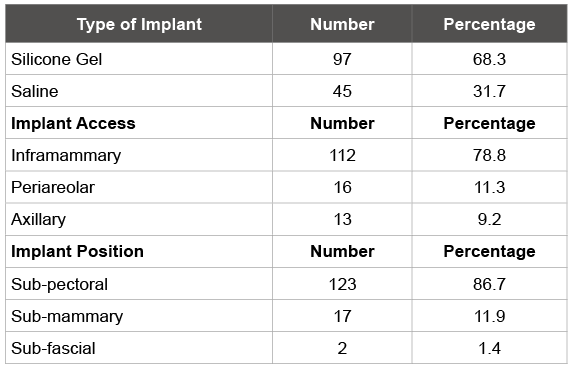
Table 1: Implant and surgical details of the study population
Breast base diameter (BBD) was one of the cardinal anthropometric measurements used to choose appropriate breast implant diameter (ID). Seventy percent (n=95) of the study population had a <1cm difference in the measured BBD and chosen prosthesis ID, while 24.7 % (n=35) had a 1-2cm difference, and only 2.1% (n=3) had a >2cm difference.
There was a 74% (n=105) 1-3 month follow up rate, and 50% (n=71) 8-12 month follow up rate. Three reoperations (2.1%) were reported during the 5-year total study period: One immediate hematoma, and 2 replacements for capsular contracture. There were no reoperations for size change (0% rate over 5-years). The mean satisfaction rates at the 1-3 month and 8-12 month time periods reported by patients were 94.7% and 93.64%, respectively. Similarly, the satisfaction rates reported by surgeons over the same time periods were 94.86% and 94.84%, respectively.
We further analyzed those cases in which either the patient and/or doctor rated a ≤ 80% satisfaction rate (n=19, 13.4%), which we defined as a poor outcome. We found that a high proportion of these cases had patients with known high risk factors (HRF) for poor outcome in breast augmentation surgery and/or implant selection contrary to the selection criteria of the system: 84.2% (n=16) desired a ≥3 score on a post-augmentation desired outcome scale (exaggerated post-augmentation look based on a visual scale from 1-4 in the system’s preoperative worksheet), 73.7% (n=14) had a < 2cm breast skin pinch thickness, 42.1% (n=8) had either a loose and/ or ptotic breast skin envelope in whom a simultaneous mastopexy was not performed, 42.1% (n=8) had an incorrect selection of implant profile based on the desired outcome by the patient, and 36.8% (n=7) patients had asymmetry of the breasts and/or chest wall. Eleven (57.9%) of these cases had 3 or more of the above high risk factors (HRF).
In the entire study population, there were 44 (31%) patients who had ≥ 3 HRF for poor outcome. Eleven (25%) of them had a ≤ 80% satisfaction rate, compared to 8 (8.2%) of the patients who had < 3 HRF (p=0.014). Despite a higher risk of poor outcome when patients had ≥ 3 HRF, the vast majority of this difficult patient population (n=33, 75%) had a >80% satisfaction rate with the use of the system.
A vital aspect for successful outcome in breast augmentation surgery is choosing the appropriate implant. This key step has been a major challenge for plastic surgeons. Most surgeons have their own personal method of choosing implants based on their experience. Some feel that a patient’s desired outcome is the most important determinant for choosing a particular implant, while others emphasize the patient’s anthropometric parameters as the main basis for implant choice. The reality is, it is probably a balance between both that is needed. Additionally, a successful outcome also hinges on meticulous surgical technique, detailed patient education, and proper postoperative care.
Despite all the advances in implant design and well-established surgical techniques, reoperations secondary to size change are disappointingly high, with rates quoted up to 8.7% [2-9]. This complication is most likely secondary to miscommunication between the patient and surgeon in terms of desired aesthetic outcome and/or implant volume, poor judgment on the part of the surgeon in choosing an inappropriate implant, a change of mind on the part of a patient, and/or a complication related to the size of the implant used. There is no doubt that a patient’s desired aesthetic outcome merits major consideration, however, it cannot be to the detriment of the patient’s physical and aesthetic wellbeing. Mediating this balance is a great challenge at times, especially when the desires of a patient are grossly different from the recommendations of the surgeon. A fully informed, detailed, and inclusive preoperative evaluation program is the springboard for this important discussion. Thoughtful pre-operative planning in breast augmentation surgery requires the perfect balance between five major variables: Implant (volume/weight and dimensions), breast (anthropometrics and dimensions), skin (elasticity, redundancy, and thickness), surgical approach (incision and pocket placement), and patient’s desires (cup size, cleavage, and augmented look). All these variables need to be considered appropriately, but rationally tailored to a specific patient, and based on the surgeon’s experience and expertise.
Recently, the preoperative emphasis on objective parameters, like anthropometric measurements and breast/chest anatomy, in choosing the ideal implant has gained importance among plastic surgeons. Prado [17] and Pechter [18] utilized simple tape measurements and breast sizers to choose implants based on the anatomy of the individual patient. Westreich [12] derived a mathematical formula based on breast/chest measurements to calculate the volume of the implant needed for augmentation. Tebbets [13-16], over the years, has described an evolving dimensional system (TEPID system) that takes into account the individual patient’s breast measurements and tissue/skin characteristics, and the implant dimensions that would best fit those parameters. In the most recent generation of his system, he also incorporates the ideal incision for placement and pocket location for the implant based on the objective findings garnered from his system. All these systems/formulas mathematically determine the implant of choice for a particular patient. They remove much of the guesswork and artistic license from the preoperative decision making process. In a way, this makes this step more quantitative and reproducible, especially for the less experienced breast surgeon. On the other hand, they do not factor the patient’s desires of breast size into as much consideration. This is especially true for patient’s who envision very large or small postsurgical outcomes. The literature supports the success of these systems in dramatically decreasing the reoperation rates secondary to size-change. Tebbetts showed a 0% reoperation rate for size change in 3 years using his TEPID system [16]. The main objection raised in response to these low rates of reoperation has been the absence of the data for those patients who wished size change. It is unclear if they were either persuaded not to pursue the surgery secondary to possible complications, or whether they went elsewhere for the size change procedure.
We feel that a patient’s vision of aesthetic outcome: size, volume, cleavage, and enhancement degree, are a vital aspect missing in the current bio-dimensional systems described in the literature. The absence of this variable in those systems may play an integral part in reoperations for size change. In an effort to bridge this gap, this system was developed. It intends to help surgeons choose more accurately the size, shape, type, and location of breast implants, by taking into account individual patient anthropometric measurements and tissue characteristics, as well as their individual expectation and aesthetic vision of their breast enhancement surgery. There is a visually graded 1-4 scale for desired appearance incorporated in the system that enables the patient to express their desired outcome. This gives the surgeon an idea of what the patient is envisioning from the breast enhancement surgery, and incorporates that vision into choosing the appropriate implant.
The system kit (Picture 1) includes a booklet of preoperative worksheets (Figure 1a and 1b), calipers for measurement, and an implant selection book. The worksheet captures various anthropometric measurements of the patient’s breast, skin, and chest wall, the patient’s desired outcome, and asymmetries of the anatomy (breast, inframammary fold, chest wall). The surgeon utilizes the information garnered from the worksheet, in consultation with the patient, and based on his/her experience, chooses an implant that would best fit the patient from the selection book.
This pilot study showed that most of the surgeons utilized the system as intended, and reported an extremely high (>93%) satisfaction rate by both patients and surgeons at the 3-month and 12-month follow up time frame. More importantly, there were no reoperations (0% rate) for size change reported in the 5-year total study period. It is important to note that the two reoperations for capsular contracture reported in our study had replacement of the original implants with ones of the same size.
This system was especially helpful in the preoperative planning of patients at a high risk for unsatisfactory outcomes after breast augmentation surgery. Patients who desired an exaggerated postaugmentation look and selected a score of 3 or 4 from the pre-operative visual analogue scale (range: 1 to 4), would most likely require a larger than “ideal” volume implant to fulfill this requirement. The system would factor that consideration into the equation, and help the surgeon and patient settle on an implant that would balance the patient’s desires with her anatomy. Similarly, in a patient who was very thin and had a <2cm breast skin pinch thickness, the system would guide the surgeon to not only choose an appropriately dimensioned implant, but also guide the choice of pocket for implant placement that would suit this patient best. The same principle would hold true for patients with borderline redundant breast skin in whom a simultaneous mastopexy was not an option/planned, or had gross asymmetry of the breasts and/or chest wall. The system would ensure that the appropriate measurements and variables were incorporated into the thought process of the surgeon, and then an implant would be chosen based on a rational, intelligent, but balanced, approach. We found that there was a significantly higher dissatisfaction rate (25% vs. 8.2%; p=0.014) among those patients with ≥ 3 of these high risk factors for poor outcome compared to those who had <3 risk factors. However, this also meant that 75% of this challenging population had high satisfaction rates, showing that the use of this system potentially resulted in the majority of this cohort having a good outcome.
This was a pilot project and, as such, had some limitations. The total patient population studied was low and the follow up time frame was limited. Surgeons were self-reporting their outcomes, and patient satisfaction responses were solicited by the surgeon/his staff, both of which raise the potential for response bias related to the satisfaction rates. Additionally, the system is only a guide, and much of the final implant selection decisions are based on the experience and expertise of the individual surgeon. There was an obvious selection bias in this study as seasoned breast surgeons were used to test this system, and therefore the results may not be applicable to an ‘average’ plastic surgeon with less breast augmentation experience. Despite these weaknesses, this study did highlight that the system could be implemented easily, effectively, and successfully. A high satisfaction rate, especially in patients with high risk for poor outcome, and potentially a zero reoperation rate for size change was achieved with the help of this system. To further establish the effectiveness of this system, we are now planning further large population, randomized trials with >5 year follow up as the next step forward given the encouraging findings of our pilot project.
This study shows that an anthropometric-based system guided surgeons and patients effectively in choosing implants that resulted in high outcome satisfaction rates. There were no reoperations for size change in the 5-year total study period. This system was especially successful in difficult cases that had a high risk for poor outcome.
Support for this study was provided by Mentor Corporation, LLC. The company had no role in the design or execution of this study.
The authors thank the following surgeons and their office staff who participated in this study: Dr. Brad Calobrace, Dr. Mark Codner, Dr. Julius Few, Dr. Rich Greco, Dr. Roxanne Guy, Dr. Nana Mizuguchi, Dr. David Reath, Dr. Louis Strock, and Dr. Jennifer Walden.
Download Provisional PDF Here
Aritcle Type: Research Article
Citation: Choudry U, Kim N, Cunningham B (2016) The Use of An Anthropometric - Based PreOperative System to Choose Implants in Primary Breast Augmentation – An Outcome Analysis. J Surg Open Access 2(1): doi http://dx.doi.org/10.16966/2470-0991.113
Copyright: © 2016 Choudry U, et al. This is an open-access article distributed under the terms of the Creative Commons Attribution License, which permits unrestricted use, distribution, and reproduction in any medium, provided the original author and source are credited.
Publication history:
All Sci Forschen Journals are Open Access